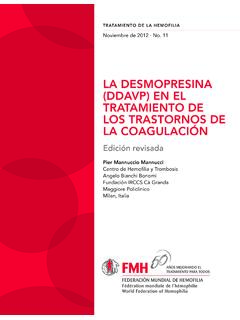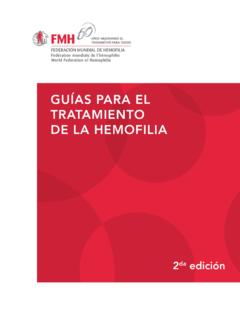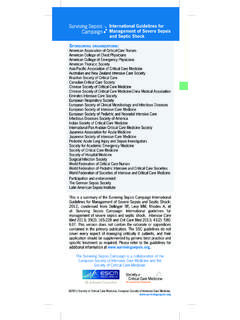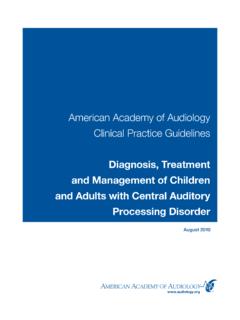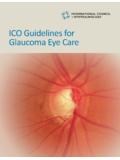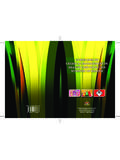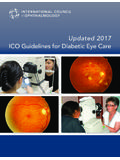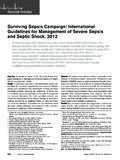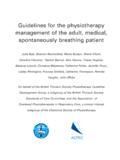Transcription of GUIDELINES FOR THE MANAGEMENT OF …
1 GUIDELINES FOR THE MANAGEMENT OF hemophilia 2nd editionThese GUIDELINES were originally published by Blackwell Publishing in Haemophilia; Epub 6 JUL 2012. DOI: They are reprinted with their permission. Blackwell Publishing Ltd., 2012 The WFH encourages redistribution of its publications for educational purposes by not-for-profit hemophilia organizations. For permission to reproduce or translate this document, please contact the Communications Department at the address publication is accessible from the World Federation of hemophilia s website at Additional copies are also available from the WFH at: World Federation of Hemophilia1425, boul. Ren -L vesque O., bureau 1010 Montr al, Qu bec H3G 1T7 CanadaTel.: (514) 875-7944 Fax: (514) 875-8916E-mail: FOR THE MANAGEMENT OF hemophilia 2nd editionPrepared by the Treatment GUIDELINES Working Group, on behalf of the World Federation of hemophilia (WFH) Dr.
2 Alok Srivastava (Chair)Department of Hematology, Christian Medical College, Vellore, Tamil Nadu, IndiaDr. Andrew K. BrewerDepartment of Oral Surgery, The Royal Infirmary, Glasgow, ScotlandDr. Eveline P. Mauser-Bunschoten, Van Creveldkliniek and Department of Hematology, University Medical Center Utrecht, Utrecht, the NetherlandsDr. Nigel S. Key Department of Medicine, University of North Carolina, Chapel Hill, NC, Steve KitchenSheffield Haemophilia and Thrombosis Centre, Royal Hallamshire Hospital, Sheffield, UKDr. Adolfo LlinasDepartment of Orthopaedics and Traumatology, Fundaci n Santa Fe University Hospital Fundaci n Cosme y Dami n and Universidad de los Andes and Universidad del Rosario, Bogot , ColombiaDr. Christopher A. LudlamComprehensive Care Haemophilia and Thrombosis Centre, Royal Infirmary, Edinburgh, Johnny N.
3 MahlanguHaemophiia Comprehensive Care Centre, Johannesburg Hospital and Department of Molecular Medicine and Haematology, Faculty of Health Sciences, National Health Laboratory Services and University of the Witwatersrand, Johannesburg, South Africa Kathy MulderBleeding Disorders Clinic, Health Sciences Center Winnipeg, CanadaDr. Man-Chiu PoonDepartments of Medicine, Pediatrics and Oncology, and Southern Alberta Rare Blood and Bleeding Disorders Comprehensive Care Program, University of Calgary, Foothills Hospital and Calgary Health Region, Alberta, CanadaDr. Alison StreetDepartment of Haematology, Alfred HospitalMelbourne, AustraliaAcknowledgementsA professional agency was engaged to assist with the literature search and to grade the evidence. In addition, given the fact that many recommendations are based on expert opinion, a draft version of these GUIDELINES was circulated to many others involved in hemophilia care outside of the writing group.
4 The authors are grateful to those who provided detailed comments. Finally, we would like to acknowledge the extraordinary effort from WFH staff, Jennifer Lalibert , and also Elizabeth Myles, in completing this work. DisclaimerThe World Federation of hemophilia (WFH) does not endorse particular treatment products or manu-facturers; any reference to a product name is not an endorsement by the WFH. The WFH does not engage in the practice of medicine and under no circumstances recommends particular treatment for specific individuals. Dose schedules and other treatment regimens are continually revised and new side-effects recognized. These GUIDELINES are intended to help develop basic standards of care for the MANAGEMENT of hemophilia and do not replace the advice of a medical advisor and/or product insert information.
5 Any treatment must be designed according to the needs of the individual and the resources and introduction ..61. General care and MANAGEMENT of hemophilia .. What is hemophilia ? ..7 Bleeding manifestations .. Principles of care .. Comprehensive care ..9 Comprehensive care team ..9 Functions of a comprehensive care program .. Fitness and physical activity .. Adjunctive MANAGEMENT .. Prophylactic factor replacement therapy ..12 Administration and dosing schedules .. Home therapy .. Monitoring health status and outcome Pain MANAGEMENT ..15 Pain caused by venous access ..15 Pain caused by joint or muscle bleeding ..15 Post-operative pain ..15 Pain due to chronic hemophilic arthropathy .. Surgery and invasive procedures .. Dental care and MANAGEMENT ..17 References.
6 182. Special MANAGEMENT issues .. Carriers .. Genetic testing/counselling and prenatal diagnosis .. Delivery of infants with known or suspected hemophilia .. Vaccinations .. Psychosocial issues .. Sexuality .. Ageing hemophilia patients ..24 Osteoporosis ..24 Obesity ..24 Hypertension ..24 Diabetes mellitus (DM) ..24 Hypercholesterolemia ..25 Cardiovascular disease ..25 Psychosocial impact .. Von Willebrand disease and rare bleeding disorders ..25 References ..263. Laboratory diagnosis .. Knowledge and expertise in coagulation laboratory testing ..29 Principles of diagnosis ..29 Technical aspects ..29 Trained personnel .. Use of the correct equipment and reagents ..32 Equipment ..32 Reagents .. Quality assurance ..34 Internal quality control (IQC).
7 34 External quality assessment (EQA) ..34 References ..34 CONTENTS4. Hemostatic agents .. Clotting factor concentrates ..37 Product selection ..37 FVIII concentrates ..38 FIX concentrates .. Other plasma products ..40 Fresh frozen plasma (FFP) ..40 Cryoprecipitate .. Other pharmacological options ..41 Desmopressin (DDAVP) ..41 Tranexamic acid ..42 Epsilon aminocaproic acid ..43 References ..435. Treatment of specific hemorrhages .. Joint hemorrhage (hemarthrosis) ..47 Arthrocentesis .. Muscle hemorrhage ..49 Iliopsoas hemorrhage .. Central nervous system hemorrhage/head trauma .. Throat and neck hemorrhage .. Acute gastrointestinal (GI) hemorrhage .. Acute abdominal hemorrhage .. Ophthalmic hemorrhage .. Renal hemorrhage .. Oral hemorrhage .. Epistaxis .. Soft tissue hemorrhage.
8 Lacerations and abrasions ..53 References ..536. Complications of hemophilia .. Musculoskeletal complications ..55 Synovitis ..55 Chronic hemophilic arthropathy ..56 Principles of physiotherapy/physical medicine in ..58 Fractures ..58 Principles of orthopedic surgery in hemophilia .. Inhibitors ..59 MANAGEMENT of bleeding ..60 Allergic reactions in patients with hemophilia B ..61 Immune tolerance induction ..61 Patients switching to new concentrates .. Transfusion-transmitted and other infection-related complications ..61 Principles of MANAGEMENT of HIV infection in hemophilia ..62 Principles of MANAGEMENT of HCV infection in hemophilia ..62 Principles of MANAGEMENT of HBV infection in hemophilia ..62 Principles of MANAGEMENT of bacterial infection in hemophilia ..63 References.
9 637. Plasma factor level and duration of administration .. Choice of factor replacement therapy protocols ..69 References ..73 Appendix I Oxford Centre for Evidence-Based Medicine, 2011 Levels of Evidence ..74 TABLES AND FIGUREST able 1-1: Relationship of bleeding severity to clotting factor level ..8 Table 1-2: Sites of bleeding in hemophilia ..8 Table 1-3: Approximate frequency of bleeding at different sites ..8 Table 1-4: Definitions of factor replacement therapy protocols ..12 Table 1-5: Strategies for pain MANAGEMENT in patients with hemophilia ..15 Table 1-6: Definition of adequacy of hemostasis for surgical procedures ..16 Table 3-1: Interpretation of screening tests ..31 Table 5-1: Definition of response to treatment of acute hemarthrosis ..48 Table 7-1: Suggested plasma factor peak level and duration of administration (when there is no significant resource constraint).
10 71 Table 7-2: Plasma factor peak level and duration of administration (when there is significant resource constraint) ..72 Figure 7-1: Strategies for clotting factor replacement at different ages and impact on outcomes ..69 GUIDELINES FOR THE MANAGEMENT OF HEMOPHILIA6 The first edition of these GUIDELINES , published in 2005 by the WFH, served its purpose of being a useful document for those looking for basic infor-mation on the comprehensive MANAGEMENT of hemophilia . The need for revision has arisen for several reasons. The most significant of these was to incorporate the best existing evidence on which recommendations were based. There is recent high quality data from randomized controlled trials estab-lishing the efficacy and superiority of prophylactic factor replacement over episodic treatment though the optimal dose and schedule for prophylaxis continue to be subjects of further research.




